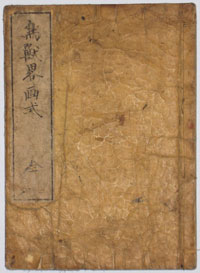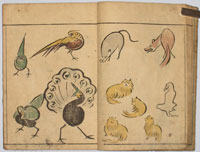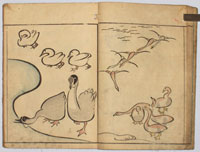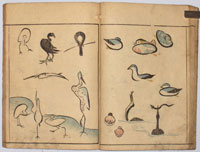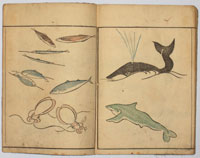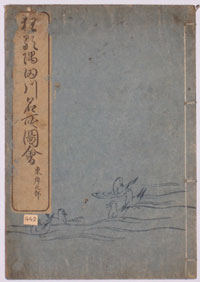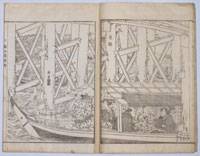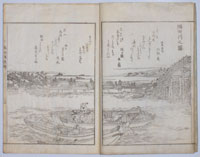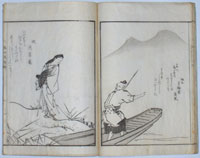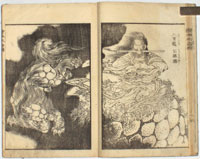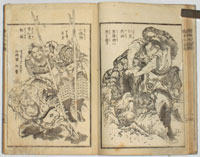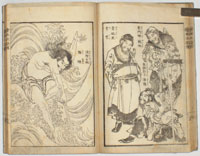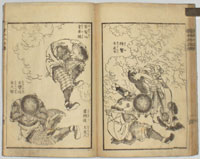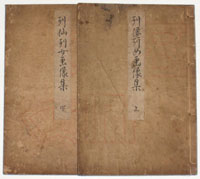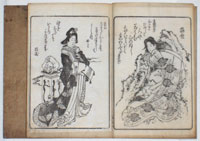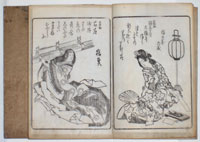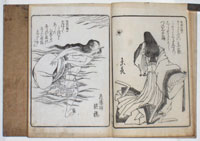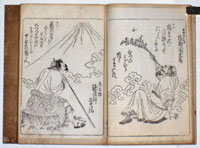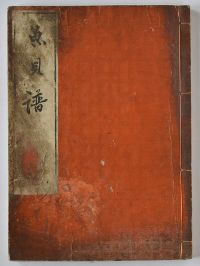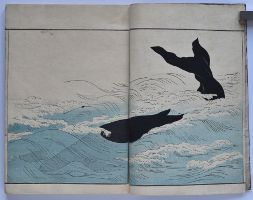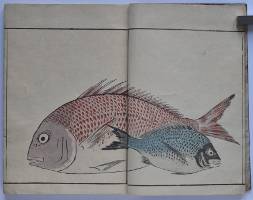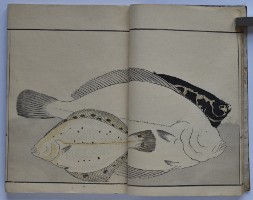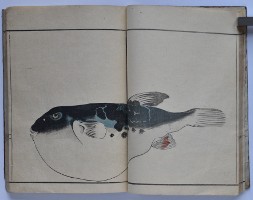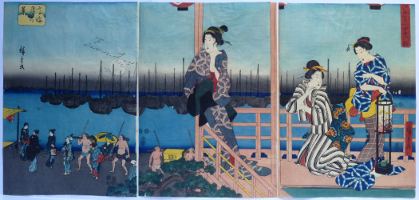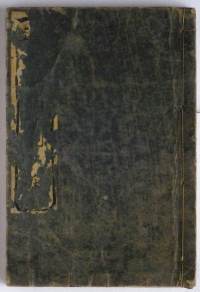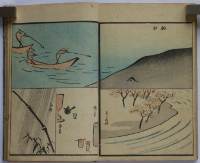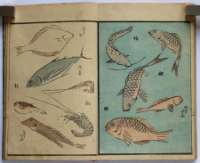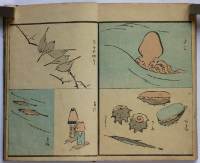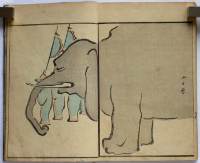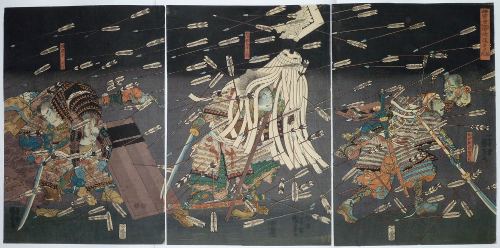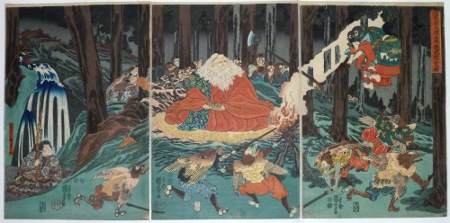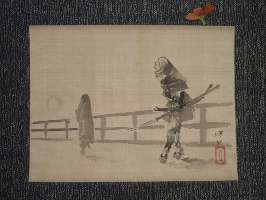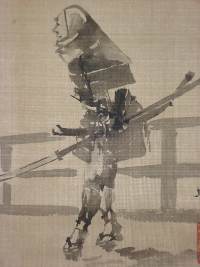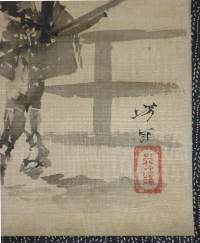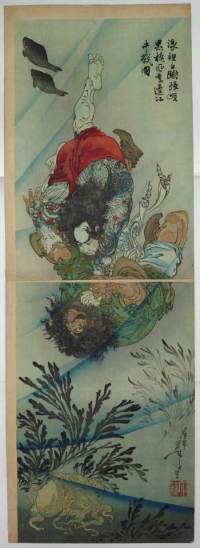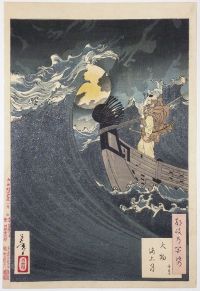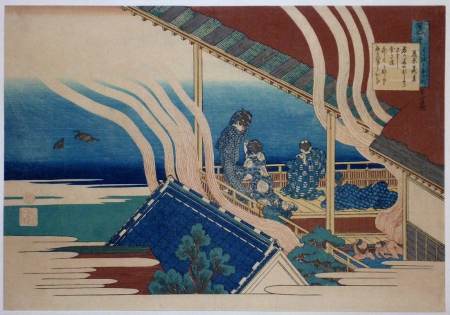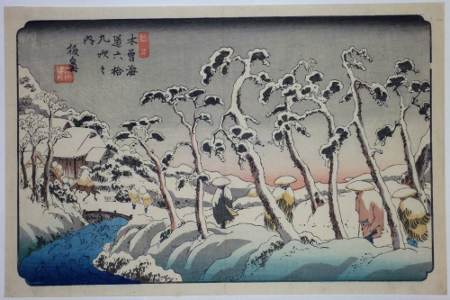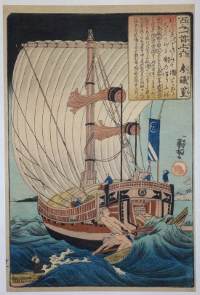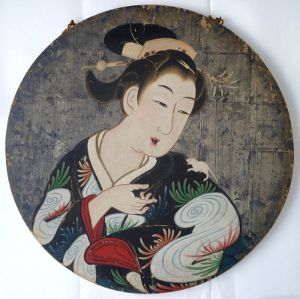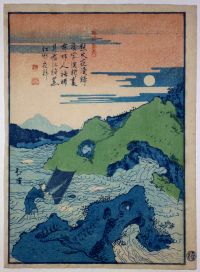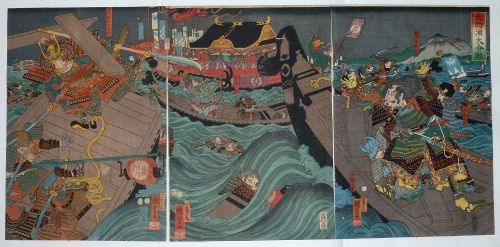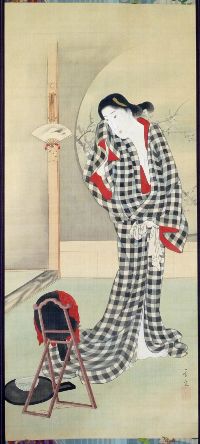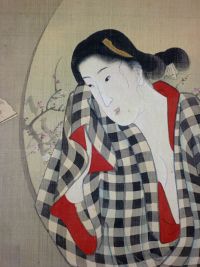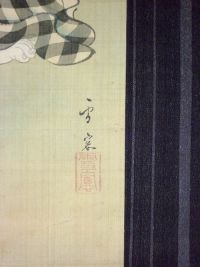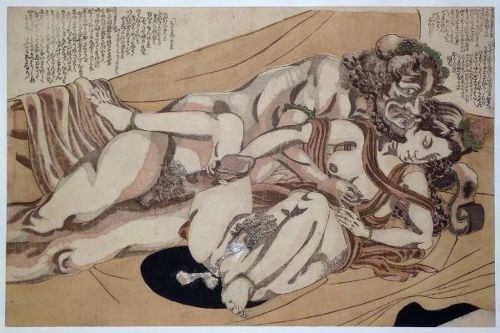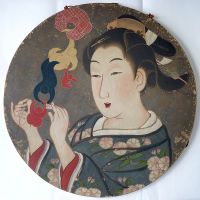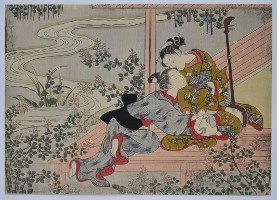/category/archive/page/23/
Kitao MASAYOSHI (1764-1824)
Click here to view image full size.
One volume complete Choju ryakugashiki, “Simplified Forms of Drawing Birds and Flowers.” Published Kwansei 9, 1797, by Suharaya Ichibei. Illustrated by Kuwagata Keisai ( Masayoshi ). These influential books of Masayoshi’s were popular and were reprinted many times.
Fine early copy. Original title slip and lemon-yellow covers ( some wear ). Some thumbing at bottom especially towards front, and other minor marks, otherwise good condition. Unidentified collectors’ seals at end and small annotation on back cover of a previous (?) collector: L. de la Bedollier.
Status: Sold
Teisai HOKUBA (177 -1844)
Click here to view image full size.
One volume complete Kyoka sumidagawa meisho zue, ” Humorous Poems on Famous Views of the Sumida River.” Colophon dated Bunsei 6, 1823, published by Shunsuien. Extremely rare.
Original covers with a printed design of chidori. Original title slip. Very good condition.
Status: Sold
Utgawa HIROSHIGE (1797-1858)
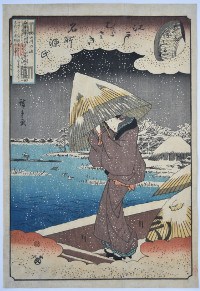
Click here to view image full size.
One of a set: Edo Murasaki meisho Genji, “Murasaki’s Genji in Famous Places of Edo.” Mitate Ukifune Sumidagawa no watashi, “A Parody of Ukifune Crossing the Sumida River.” Shows a beauty on a ferry crossing the Sumida River in heavy snow, representing Ukifune, one of the court ladies of the Genji Monogatari. Stylised clouds above and below copying the traditional kiri-gane gold found on Yamato-e scrolls. These Genji pictures were popular at this time to circumvent the reforms of 1842. Published by Kinseido (his seal also appearing on the umbrella bottom right). A rare set.
Fine impression. Very good colour. Minor soil, otherwise very good condition. Signed Hiroshige ga.
Status: Sold
Katsushika HOKUSAI (1760–1849)
Click here to view image full size.
One volume complete Ehon Suikoden, “A Picture Book of the Suikoden”, published by Kadomaruya Jinsuke, Bunsei 12, 1829 showing 108 Chinese brigands. Some fine designs. Signed Katsushika Zen Hokusai I-itsu fude.
Fine impressions. Original covers lacking title slip. Some slight foxing and minor marks.
Status: Sold
Yashima GAKUTEI (1786-1868) and Totoya HOKKEI (1780-1850)
Click here to view image full size.
Two vols. kyoka books complete: Ressen retsujo gazoshu, a “Collection of the Portraits of Immortal Men and Women.” Twenty eight portraits of Chinese hermits and twenty one portraits of celebrated women in Japanese history. Being a selection of kyoka presented at the meetimg held at Kawachiya of Yanagibashi Ryogoku in Edo, 1st day of the 9th month, Bunsei 7 ( 1824 ). Published by Shinsenyen. Rare.
Original covers and title slips. Minor marks to covers, otherwise very good condition.
Status: Sold
Keisai MASAYOSHI (1764-1824)
Click here to view image full size.
One volume complete Gyokai ryakugashiki, “Fishes and Shells in the Abbreviated Style of Drawing.” Published in Osaka by Fukusada Tobei, 1813. Originally published in 1802 with alternative title and poems by Ichiyosei Sogai and others. 31 sheets numbered 1-31. Initial page with title and illustrator Kuwagata Keisai (Kitao Masayoshi). Colophon with date Bunka 10 (1813), engravers and publisher.
Some minor soil and damage to covers, otherwise good condition. Extensive use of mica on various pages.
Status: Sold
Ichiryusai HIROSHIGE (1797-1858)
Click here to view image full size.
Autumn from a set of four triptychs, Edo meisho shiki-no nagame, “Famous Places in Edo in the Four Seasons.” An evening scene with beauties on a balcony overlooking the bay at Takanawa. Birds are descending across a full moon. Published by Marujin, 1848-9. All four triptychs from this set are masterpieces.
Fine impression. Perfect colour. Slight thinning and creasing, otherwise fine condition. Signed Hiroshige ga.
Status: Sold
Ichiryusai HIROSHIGE (1797-1858)
Click here to view image full size.
A copy of Ryakuga Korin-fu Ryusai hyakuza, the One Hundred Abbreviated Drawings by Ryusai [Hiroshige]. 1 vol. complete: 21 sheets; inside front cover title and illustrator Hiroshige (also given on last page). 3pp. preface dated Kaei 4 (1851) and signed Ryukatei Tanekazu and 20 pages, numbered, with illustrations in sumi, blue and pink. Colophon inside back cover with a list of bookshops (?) in Osaka and Edo and publisher Yoshidaya Genpachi. According to Brown (L.N.Brown, Block Printing And Book Illustration In Japan , George Routledge & Sons Ltd. 1924, p. 195) this book was republished as vol. IV of Sohitsu gafu. Original covers, missing title slip. Contents very good with only minor marks.
Status: Sold
Utagawa KUNIYOSHI (1797-1861)
Click here to view image full size.
Nanke yushi Shijo-nawate nite uchijini. The last stand of the Kusunoki clan at Shijo-nawate in 1348. Kusunoki Masatsura, shown on the far left propped against his fallen horse under a rain of arrows, continues his father’s struggle against the Ashikaga forces. Wada Shinbochi (Genshu) leads the way holding enemy heads followed by Masatomo with a battle standard. Their blue complexions anticipate their imminent demise. Published by Fujioka-ya Keijiro, 1851-2. Robinson T271.
Fine impression. One small backed wormhole on title, otherwise very good condition. Full size. Signed Ichiyusai Kuniyoshi ga.
Status: Sold
Utagawa KUNIYOSHI (1797-1861)
Click here to view image full size.
A triptych showing Ushiwaka Maru (Minamoto no Yoshitsune’s childhood name), attended by Kisanda, practising fencing with the karasu or “crow” tengu in a forest glade on Mt Kurama, north of Kyoto. His training in martial arts is being supervised by a white-bearded yamabushi tengu, Sojobo, King of the Tengu. (The yamabushi were followers of Shugendo – a shamanistic mountain ascetism.) Yoshitsune (1159-1189) is the best known Japanese warrior and a popular subject for Japanese artists and craftsmen. Famous for exploits such as the battle on Gojo Bridge with Benkei and the battle of Dan-no-ura. Published by Enshuya Hikobei, 1851-2. Robinson T264.
Fine impression. This is the first state with gradation on the rocks top left. Fine colour. Very good condition. Signed Ichiyusai Kuniyoshi ga.
Status: Sold
Utagawa KUNIYOSHI (1797-1861)
Click here to view image full size.
An extremely rare diptych showing Princess Wakana (left) played by Bando Shuka I and the warriors Genkai Nadaemon played by Arashi Rikan III; Washizu Rokuro played by Arashi Rikaku II; Wachizu Shichoro played by Bando Takesaburo I. The play Shiranui monogatari, “The Tale of the White Embroiderer” was performed at the Kawarazaki Theatre, 2/1853. The story (from a late Edo novel) tells of the feud between Wakana and the Kikuchi clan who killed her family. She is rescued by a spider who gives her the power of spider magic which, with the aid of a spider scroll, enables her to conjure up a giant spider to assist her. Published by Kakumoto-ya Kinjiro. This is the only complete impression I have seen and I can only find one other recorded example (listed in the Kuniyoshi Project).
Fine impression and colour. Small edge binding holes, otherwise fine condition Signed Ichiyusai Kuniyoshi ga.
Status: Sold
Tsukioka YOSHITOSHI (1839-1892)
Click here to view image full size.
An original painting showing what is probably the most famous encounter in Japanese mythology: The scene is evening on Gojo Bridge in Kyoto where the twenty year old Benkei ambushes samurai to steal their swords. He is shown approaching the flute-playing Yoshitsune. A fight ensues which Yoshitsune wins due to his leaping ability taught to him by the mountain tengu. Yoshitsune pardons Benkei and they become loyal friends. This painting, in shades of sumi, beautifully evokes the crepuscular gloom. On silk, 7 x 9.5 in; 17.75 x 24.1 cms. Painted c late 1870s. Signed Yoshitoshi with Taiso seal.
Status: Sold
Tsukioka YOSHITOSHI (1839-1892)
Click here to view image full size.
A vertical diptych showing Cho Jun, the white stripe in the waves, wrestling in the river with Ri Ki, the black whirlwind. Ronhakucho Chojun kokusempu Riki kochu ni tatakau no zu. The story concerns the river pirate, Ri Ki, who is caught stealing fish by Cho Jun and the ensuing underwater battle. Initially, Ri Ki has the upper hand but Cho Jun challenges him again and they fight until Ri Ki’s compatriots stop the engagement and invite Cho Jun to join their gang. Published by Matsui Eikichi, 1887. This is the extremely rare first state before the publisher and date in left margin. See my blog.
Very fine impression. Fine colour. Slight discolouration to top margins, otherwise fine condition. Full margins all round with ample room for joining. Signed Oju Yoshitoshi hitsu.
Status: Sold
Tsukioka YOSHITOSHI (1839-1892)
Click here to view image full size.
The best design from the set Tsuki hyakushi, the “Hundred Phases of the Moon”. The set published between 1885 and 1892 ( this being 1886 ) by Akiyama Buemon. Benkei against a full moon. In 1185 Yoshitsune attacked by his half-brother Minamoto no Yoritomo, was forced to flee to northern Japan by ship. Sailing along the Inland Sea off the coast of Harima Province not far from Kyoto, the ship was struck by a storm in Daimotsu Bay caused by the vengeful ghosts of the Taira warriors Yoshitsune and his men had slain. Benkei pacified the spirits in the prow of the boat by holding up his string of prayer beads.
Fine impression, colour and condition. (A good guide to the quality of the impression is to look at the outline of Benkei’s face: This fine line started to break down early on.) An impression that has not been in an album: Full margins with very extensive mica. Signed Yoshitoshi.
Status: Sold
Katsushika HOKUSAI (1760-1849)
Click here to view image full size.
A poem by Fujiwara no Yoshitaka (954-974) from Hyakunin isshu uba ga etoki, the “Hundred Poems Explained by the Wet Nurse.” Published by Eijudo and Iseri, c 1835-6. Although obviously intended to be a set of 100 prints, only 27 are known plus drawings for others. The poet speaks of a trivial life prior to meeting his lover. Two women and their companions relax after a bath admiring the view across water. Steam rises from the bath and two cormorants are seen on the left. A languid scene and one of Hokusai’s most beautiful designs.
Fine impression, colour and condition. Full size. Two states are known: the printers quickly discovered that the red seal at left was not easily discernable and cut the green block to correct this. Signed Zen Hokusai.
Status: Sold
Keisai EISEN (1790-1848)
Click here to view image full size.
Itahana from Kisokaido rokujukyutsugi no uchi, “Sixty-Nine Stations of the Kisokaido.” The set of seventy prints was started by Eisen and published by Hoeido in 1835, but in 1837 Hiroshige took over and completed the series with the publisher Iseya Rihei (Kinjudo). One of the best designs from the set. This design is never signed, even, as here, on the first edition. Rare.
Fine impression and colour. This is the first edition with gradation on the river and the river bank. Slight centre fold, otherwise fine condition. Ex Pulverer collection and purchased from me in 1974.
Status: Sold
Utagawa KUNIYOSHI (1797-1861)
Click here to view image full size.
The stern of a large sailing-junk and a smaller vessel infront. A poem by Sangi Takamura (Ono no Takamura) from Hyaku-nin isshu, “The Hundred Poets” published by Ebine c 1838. Depending which story one reads, either Takamura, who was a customs official for ships trading to and from China, went missing on a mission or was reported for being an extortioner and banished to the Oki Islands. Either way, he was subsequently pardoned. One of the best designs from this fine set. Robinson S19.11 and illustrated in Robinson (1961), no. 59.
Fine impression. Very good colour. Remargined top and bottom, otherwise very good condition. Signed Ichiyusai Kuniyoshi ga.
Status: Sold
Tsukioka SETTEI (1710-1786)
Click here to view image full size.
An interesting large painting, full colour on paper mounted on a wooden frame, 25.5 in; 62cms in diameter showing a bust portrait of a beauty with elaborate coiffure and a white mouse. Although not signed, the attribution is unquestionable, painted between 1767-1773 in Osaka. It appears to have been commissioned to hang in a hairdresser’s or cosmetic shop and has metal eyes at the top. The oxidised silver leaf background was meant to resemble a mirror and the idea of busts reflected in mirrors and silver grounds was later employed by Utamaro and Sharaku. Besides silver, gum and raised painting is applied. Such signboards appear in an illustrated book by Hasegawa Mitsunobu published in Osaka in 1752. This new discovery has been written about by Dr. Yamamoto Yukari in vol.27 of Minzoku Geijutsu (Ethno-Arts) in 2011. Minor surface marks all over but astonishingly good condition given their age and use. Extremely rare.
Status: Sold
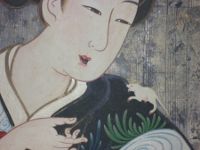
Click here to view image full size.
Totoya HOKKEI (1780-1850)
Click here to view image full size.
A fisherman with a scoop and net seemingly trying to catch the moon’s reflection. One of an excessively rare chuban series with title Toshi gafu no uchi, “Drawing Album for Chinese Poems” printed in red, and sub-title Toshin denshi. Printed in tones of blue except for a light flush on the horizon. Another impression ( trimmed ) was in the Vever collection ( ex Hayashi ), Sotheby’s, Part III, lot 295. Other impressions ( damaged ) are in the BM, ref: 1937, 0710,0,230 and Honolulu Museum of Art, ref: 14463. Hokkei was one of Hokusai’s best pupils and designed many fine surimono.
Fine impression, colour and condition. Signed Hokkei.
Status: Sold
Utagawa KUNIYOSHI (1797-1861)
Click here to view image full size.
Daimotsu-no-ura o-kassen. A triptych showing the battle of Dan-no-ura. The clash between the Minamoto (Genji) clans and the Heike (Taira) clans happened in 24/3/1185 when the Taira were defeated by Yoshitsune. He is shown here on the left making his leap pursued by Noritsune. The Imperial barge is in the background. Published by Moriya Jihei, 1856. Robinson T337.
Fine impression and colour. Slight trimming, otherwise very good condition. Signed Ichiyusai Kuniyoshi ga.
Status: Sold
Utagawa YOSHIHIDE (1832-1902)
Click here to view image full size.
A painting in full colour on silk, 33.75 x 14.4 in; 85.6 x 36.6 cms. Shows a beauty after a bath looking down at her mirror. Yoshihide was a pupil of Kuniyoshi. In extremely good condition. Signed and sealed Sesso. Inscription guarantee on inside of box: “Late February in the 56th Year of the Showa era (1981).” Appraised, signed and sealed by Mr Tosuke Kimura.
Status: Sold
Yanagawa SHIGENOBU (1787-1832)
Click here to view image full size.
A European couple in flagrante from a set Yanagi no arashi, “Storm of Willows” published c 1832. This highly unusual shunga print with chiaroscuro modelling is obviously based on imported woodcuts and engravings from Europe. There also exist several other shunga prints showing Dutchmen. See Shunga sex and pleasure in Japanese art, Timothy Clark et al, BM, 2013, no 120, p. 402.
Very good impression, colour and condition. Mica applied to the vulva. The set is unsigned but generally accepted as being by Shigenobu.
Status: Sold
Tsukioka SETTEI (1710-1786)
Click here to view image full size.
An interesting large painting, full colour on paper mounted on a wooden frame, 25.5 in; 62cms in diameter showing a bust portrait of a beauty with elaborate coiffure hanging paper acrobats. Although not signed, the attribution is unquestionable, painted between 1767-1773 in Osaka. It appears to have been commissioned to hang in a hairdresser’s or cosmetic shop and has metal eyes at the top. The oxidised silver leaf background was meant to resemble a mirror and the idea of busts reflected in mirrors and silver grounds was later employed by Utamaro and Sharaku. Besides silver, gum and raised painting is applied. Such signboards appear in an illustrated book by Hasegawa Mitsunobu published in Osaka in 1752. This new discovery has been written about by Dr. Yamamoto Yukari in vol.27 of Minzoku Geijutsu (Ethno-Arts) in 2011. Minor surface marks all over but astonishingly good condition given their age and use. Extremely rare.
Status: Sold
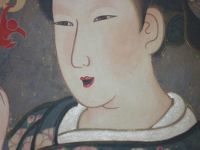
Click here to view image full size.
Terasawa MASATSUGU (active c 1760-1790)
Click here to view image full size.

Click here to view image full size.
An original two-sided sumi block for printing pages 21, 22, 23, and 24 for the shunga book Aya no odamaki, “A Twist of Figured Cloth.” (See Sex and the Floating World, Timoin Screech, BM, 1999, p. 32-33.) The book was published in 1776. Also illustrated and described in Eiri Shunga Ehon Mokuroku, Tokyo 2007, p. 79. Extremely rare. Sold “as is” with imperfections (mostly wormage). See my blog.
Status: Sold
Terasawa MASATSUGU (active c 1760-1790)
Click here to view image full size.

Click here to view image full size.
An original two-sided sumi block for printing pages 9, 20, 18, and 19 for the shunga book Aya no odamaki, “A Twist of Figured Cloth.” (See Sex and the Floating World, Timoin Screech, BM, 1999, p. 32-33.) The book was published in 1776. Also illustrated and described in Eiri Shunga Ehon Mokuroku, Tokyo 2007, p. 79. Extremely rare. Sold “as is” with imperfections (mostly wormage). See my blog.
Status: Sold
Terasawa MASATSUGU (active c 1760-1790)
Click here to view image full size.

Click here to view image full size.
An original two-sided sumi block for printing pages 14, 15, 16, and 17 for the shunga book Aya no odamaki, “A Twist of Figured Cloth.” (See Sex and the Floating World, Timoin Screech, BM, 1999, p. 32-33.) The book was published in 1776. Also illustrated and described in Eiri Shunga Ehon Mokuroku, Tokyo 2007, p. 79. Extremely rare. Sold “as is” with imperfections (mostly wormage). See my blog.
Status: Sold
Terasawa MASATSUGU (active c 1760-1790)
Click here to view image full size.

Click here to view image full size.
An original two-sided sumi block for printing pages 10, 11, 12 and 13 for the shunga book Aya no odamaki, “A Twist of Figured Cloth.” (See Sex and the Floating World, Timoin Screech, BM, 1999, p. 32-33.) The book was published in 1776. Also illustrated and described in Eiri Shunga Ehon Mokuroku, Tokyo 2007, p. 79. Extremely rare. Sold “as is” with imperfections (mostly wormage). See my blog.
Status: Sold
Terasawa MASATSUGU (active c 1760-1790)
Click here to view image full size.

Click here to view image full size.
An original two-sided sumi block for printing pages 5, 6, 7, and 8 for the shunga book Aya no odamaki, “A Twist of Figured Cloth.” (See Sex and the Floating World, Timoin Screech, BM, 1999, p. 32-33.) The book was published in 1776. Also illustrated and described in Eiri Shunga Ehon Mokuroku, Tokyo 2007, p. 79. Extremely rare. Sold “as is” with imperfections (mostly wormage). See my blog.
Status: Sold
Terasawa MASATSUGU (active c 1760-1790)
Click here to view image full size.

Click here to view image full size.
An original two-sided sumi block for printing pages 1, 2, 3, and 4 for the shunga book Aya no odamaki, “A Twist of Figured Cloth.” (See Sex and the Floating World, Timoin Screech, BM, 1999, p. 32-33.) The book was published in 1776. Also illustrated and described in Eiri Shunga Ehon Mokuroku, Tokyo 2007, p. 79. Extremely rare. Sold “as is” with imperfections (mostly wormage). See my blog.
Status: Sold
Suzuki HARUNOBU (1724-1770)
Click here to view image full size.
A wonderful chuban shunga print showing a young suitor leaning across an engawa and interrupting a beauty playing a shamisen by partially lifting her robe. They are surrounded by flowering bushes and a meandering stream. A rare design I cannot, at the moment, locate being illustrated. Published c. late 1760s.
Very fine impression on thick hosho. Extremely fine colour. Slight oxidation, otherwise fine condition.
Status: Sold
Katsushika HOKUSAI (1760-1849)

Click here to view image full size.
A matron with lover. A shunga sheet from the extremely rare de-luxe edition of the Fukujuso, “The Adonis Plant.” The blocks were re-carved, the text deleted, a mica ground added, and sumptuous hand-colouring applied and was renamed Nami chidori, “Plovers Above the Waves.” This was a costly exercise and was obviously directed at a few wealthy clients. Hokusai’s best shunga set with large figures often completely filling the space. Published c 1820. Another example illustrated in Richard Lane, Hokusai, Life And Work, Barrie & Jenkins, 1989, no. 224, p. 168.
Fine impression. Wonderful fresh carefully hand-applied colour with mica ground. Album backing. Centre fold (as usual) and slight soil to corner. But otherwise very good condition.
Status: Sold
Torii KIYONOBU I (1664-1729)

Click here to view image full size.
A large sumi oban showing a couple in flagrante. These prints were normally issued in sets of twelve and would only have had the signature on the first sheet. Published c 1704-1711. Provenance: Ex Kiyoshi Shibui collection.
Very good impression. Slight edge soil and centre fold with small pin holes, but generally good condition considering the age.
Status: Sold
Suzuki HARUNOBU (1724-1770)

Click here to view image full size.
A chuban shunga print showing the occupant of a kago in flagrante with one of the porters, having seized the opportunity of a stop on the journey. Published late 1760s. Rare.
Very fine impression on thick hosho: The outlines raised in certain areas. Fine colour and condition.
Status: Sold
Suzuki HARUNOBU (1724-1770)

Click here to view image full size.
A couple in flagrante on an open engawa which has a large bowl of goldfish. There were many attempts by the Tokugawa Shogunate (1603-1868) to suppress shunga with edicts issued in 1661, 1722 and the 1790s. None of these were particularly effective and production usually resumed with most Ukiyo-e artists producing shunga prints, books or paintings. Published c. 1768. Unsigned as often with these shunga prints.
Superb impression. Fine, unfaded colour. Fine condition.
Status: Sold
Okumura MASANOBU (1686-1764)

Click here to view image full size.
The Fourth Month, Shibumukute toshimano mumami jukushi kaki, “Well Aged and Ripe Persimmon” from a set of 12 shunga prints Someiro no yama, Neya no hinagata, “Mountains of Dyed Colours, Patterns for the Bedroom.” One of the finest shunga sets; of large size and beautifully hand coloured. Published c. 1740. Others from the set are illustrated in Tim Clark, Shunga: Sex and Pleasure in Japanese Art, BM, 2013, p. 147-151. Masanobu is one of the most important figures in Ukiyo-e being the proprietor of a shop but also a publisher, an illustrator of books, print publisher, painter, and inventor of the hashira-e and uki-e as well as being at the forefront of advancements in colour printing. Rare.
Very good impression, colour and condition.
Status: Sold
Okumura MASANOBU (1686-1764)

Click here to view image full size.
The fifth month from a set of twelve prints Someiro no yama: Neya no hinagata, “Mountains of Dyed Colours: Patterns for the Bedroom.” A haiku poem relating to the time of year on each design. Published c. 1740. Shows a couple in flagrante in a room with sliding doors painted with images of Mount Fuji and the poet Ariwara no Narihira admiring the mountain. One of the great Shunga sets with fine contemporary hand-colouring: The careful colouring on impressions from this set was obviously carried out by skilled artisans and is exceptional with the sumi screens being almost painterly: Colouring is often later on early shunga prints, and even if contemporary can be slipshod. Masanobu was a great innovator, developing new formats and technical advances. Unidentified collector’s seal bottom left. Rare.
Very good impression. Slight weakening along laid lines, otherwise very good condition.
Status: Sold
Okumura MASANOBU (1686-1764)

Click here to view image full size.
A design from a set of twelve prints Someiro no yama: Neya no hinagata, “Mountains of Dyed Colours: Patterns for the Bedroom.” A haiku poem relating to the time of year on each design. Published c 1740. Shows a couple in flagrante in a room with a free-standing screen and a view outside of an engawa and garden with a stone water cistern. One of the great Shunga sets with fine contemporary hand-colouring: The careful colouring on impressions from this set was obviously carried out by skilled artisans and is exceptional with the sumi screen being almost painterly: Colouring is often later on early shunga prints, and even if contemporary can be slipshod. Masanobu was a great innovator, developing new formats and technical advances. Unidentified collector’s seal bottom right. A beautiful design. Rare.
Very good impression and condition.
Status: Sold
The KANBUN MASTER (Fl. c. 1660-1673)
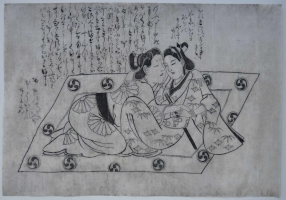
Click here to view image full size.
A large, 11.5 x 16.75 in; 29.25 x 42.5 cms, sumi print showing a courtesan with her client. These are the earliest known ukiyo-e prints with no known book, painting or print being signed. The nomenclature was given by Dr. Richard Lane because the artist worked almost entirely during the Kanbun Period (1661-1673). There is some debate as to whether all the books and prints are by the same hand, rather than by several or more individuals. However, Dr. Lane – who was the pre-eminent authority on shunga – saw a consistency in the style of drawing. Extremely rare.
Very good impression. Some slight soil, but in remarkably good condition given the date.
Status: Sold
Sugimura JIHEI (Acitive c. 1681-1703)

Click here to view image full size.
A shunga print showing a samurai (his swords lying outside the screen) having sexual intercourse with a courtesan from a set of twelve such prints published mid 1680s. Jihei was the most impressive of Moronobu’s followers and seems to have specialised in shunga, often surpassing Moronobu. (Indeed, Jihei’s work was attributed to Moronobu for a long time.) Hand coloured, although probably not from the period but still with considerable age. Extremely rare.
Fine impression. Very good condition.
Status: Sold
Suzuki HARUNOBU (1724-1770)

Click here to view image full size.
A chuban shunga print showing a fisherman taking advantage of a young girl on a boat on the Sumida River. The couple are hidden behind a four-armed scoop-net called a yotsude-ami which was used to catch whitebait in the spring. The British Museum copy (OA+,O.125) gives the location as most probably being at Mitsumata, between Eitai and Shin’o bridges, based on what looks like Lord Tayasu’s residence in the background. Another impression is illustrated in Shunga, Marco Fagioli, Octavo, 1997, no. 23, p.45. Published late 1760s. Rare.
Very good impression. Some slight fading, otherwise good condition.
Status: Sold
